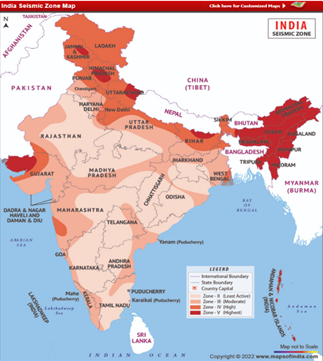

14th August 2025 (13 Topics)
Context:
The 1950 Great Assam Earthquake, with a magnitude of 8.6, marks its 75th anniversary, prompting reassessment of seismic risks in the Eastern Himalayan region.
Earthquake
- Sudden shaking or trembling of the Earth's surface caused by release of energy from the Earth’s crust.
- Primary causes:
- Tectonic plate movement
- Volcanic activity
- Artificial triggers (e.g., mining explosions, reservoir-induced seismicity)
Causes of Earthquakes
- Tectonic:
- Movement along faults due to stress build-up at plate boundaries.
- Example: Himalayan earthquakes due to Indian Plate subducting under Eurasian Plate.
- Volcanic
- Triggered by magma movement beneath the Earth’s crust.
- Example: Icelandic volcanic quakes.
- Collapse
- Due to cavern collapse (mining, karst regions).
- Explosion
- Due to man-made explosions (nuclear tests, large industrial blasts).
- Reservoir-induced
- Due to filling of large dams (changes in pressure on crustal faults).
Seismic Terms
- Focus (Hypocentre): Actual point of energy release inside the crust.
- Epicentre: Point on the Earth’s surface directly above the focus.
- Seismic Waves:
- P-waves (Primary) – fastest, travel through solids & liquids.
- S-waves (Secondary) – slower, travel only through solids.
- Surface waves – cause most damage.
- Magnitude: Quantitative measure of energy released (Richter scale).
- Intensity: Qualitative measure of shaking & damage (MSK/Mercalli scale).
Earthquake Vulnerability in India
- 59% of land at moderate–severe seismic risk (MSK VII & above).
- Three main tectonic sub-regions:
- Himalayan belt – high magnitude (>8.0) potential.
- Alluvial plains – extensions of Himalayan seismicity.
- Peninsular India – intraplate earthquakes due to ancient faults.
Historic major earthquakes:
- Shillong (1897, M 8.7), Kangra (1905, M 8.0), Bihar–Nepal (1934, M 8.3), Assam–Tibet (1950, M 8.6).
Seismic Zoning in India (BIS Classification)
|
Zone |
MSK Intensity |
Risk Level |
Examples |
|
V |
IX & above |
Very High |
Kashmir valley, NE States, A&N Islands, Rann of Kutch |
|
IV |
VIII |
High |
Delhi, parts of J&K, Himachal, Uttarakhand, Sikkim |
|
III |
VII |
Moderate |
Kerala, Goa, parts of MP, Odisha, AP |
|
II |
VI or less |
Low |
Remaining parts of Rajasthan, MP, TN |
Impacts of Earthquakes
- Structural Damage – Building collapse, >90% casualties in India due to this.
- Surface Rupture & Ground Displacement – Disrupts roads, pipelines, railways.
- Tsunamis – Triggered by undersea earthquakes (esp. subduction zones).
- Liquefaction – Water-saturated soils lose strength during shaking.
- Fires – Due to ruptured fuel pipes & electrical failures.
- Livelihood Disruption – Economic slowdown, loss of employment.
Mitigation Strategies
- Structural: Earthquake-resistant building codes, retrofitting old structures.
- Planning: Avoid high-risk areas for settlements.
- Awareness: Drills, school safety programs.
- Preparedness: Emergency kits, evacuation routes.
- Technological: Seismic microzonation, early warning systems.
India’s Preparedness Initiatives
- National Centre for Seismology (NCS) – Monitors quakes via 115 observatories.
- National Earthquake Risk Mitigation Project (NERMP) – Focus on Zones IV & V.
- Seismic Microzonation – Mapping vulnerability of large cities.
- NDMA Campaigns – Public awareness & preparedness.
- BIS Building Codes – Guidelines for earthquake-resistant structures.
- Earthquake Disaster Risk Index – Prioritises high-risk cities for preparedness.
Challenges
- High Seismic Activity – Costly retrofitting in active zones.
- Unplanned Urbanisation – Violations of safety codes (Delhi: ~80% non-compliance).
- Tourism in Risk Zones – Increased exposure in Himalayan belt.
- Lax Regulation Enforcement – Weak inspection & penalties.
- Low Public Awareness – Poor safety literacy.
- Financial Constraints – Limited funds for seismic safety programs.
Way Forward
- Strict enforcement of building codes.
- Integrate earthquake risk into urban planning.
- Public education campaigns.
- Strengthen early warning systems.
- Increase R&D in seismic technology.
- Dedicated funds for retrofitting and infrastructure strengthening.


